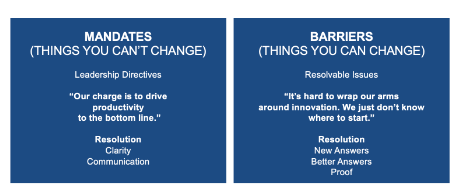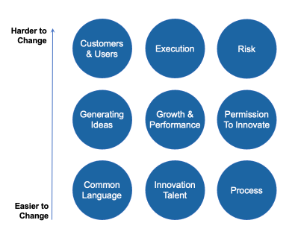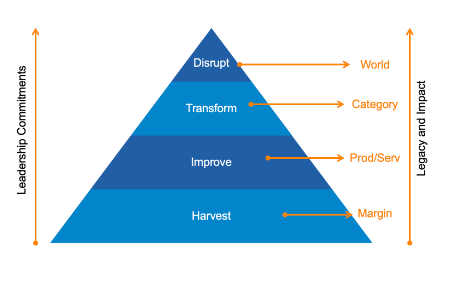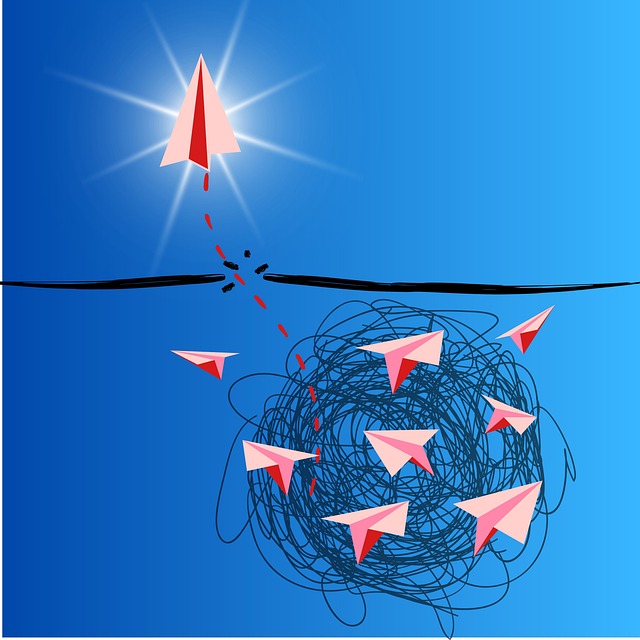Are You a Disruptor? Find Out Here!
This is the first in a series of deep dives into the Innovation Team tasked with making your business truly (and successfully) innovative.
About Innovation Teams
Team composition is a critical success factor when developing a new innovation. Many initiatives go off target before they even start because the team members were misaligned from the beginning. I remember, on one occasion, meeting with the Chief Digital Officer of a mid-sized hospital system who lamented that his big ideas always ended up smaller and less impactful. He blamed the outcomes on the process, but as we will see, the root cause was actually team composition. More recently, I had coffee with the CEO of a medical startup that was developing a solution for running patient drug trials. She shared that her team was enthusiastic about their solution, however, when they would do investor pitches, the concepts tended to flop under pressure. Why was this, she asked?
These two examples highlight the trouble that innovation teams get into, but also provide clues to the path forward. When we are faced with building a team to solve complex problems, we have our “go-to” methods for team selection. Whether based on comfort, familiarity, or falling back on what has always been done, it is easy to default to certain groupings, even if the mix of members isn’t quite right. The least impactful tends to be the “friends and family” team that comprises work pals, even if they may not have the right blend of skills for the task at hand. Team members in this arrangement often have thinking profiles that resemble the team leader, and therefore don’t offer much in the way of differentiated problem solving.
Many organizations erect cross-functional teams, which are composed of team members across a range of disciplines, so you have a blend of perspectives at the table. While variety can bring diversified solutions, this tactic can also fall short because it doesn’t take into account the creative or critical needs of advanced problem-solving. Still, other organizations assemble teams based solely on skills or expertise. These tend to be tilted toward a group of individuals who are so skilled in their particular field that their biases and critical filters can be insurmountable, which may also lead to suboptimal outcomes. An example of this frequently occurs in healthcare, where we often see a technology bias in innovation, which creates an invisible barrier and can stall out innovation.
To explore teams more deeply, and how best to assemble them to achieve your innovation goals, we can begin by looking at the types of innovations that bring teams together.
Innovative Ideas Happen along a Spectrum
Not every idea is going to reinvent an industry. In fact, new ideas occur along a spectrum, usually driven by the mandates of the organization. If we are seeking to make the current solutions in the marketplace obsolete, we will naturally strive for innovations that require bigger risks and deeper R&D. Other times, we may be looking to protect our market share or capture more margin. These types of innovations are lower risk and the impact is much smaller and less differentiating.
At Teaming Worldwide, we utilize Intentional Innovation®, a commercially proven innovation operating system designed to simplify and implement higher-performing, longer-lasting solutions that drive growth, new revenue streams, and deeper customer engagement. Through this lens, we’ve identified four basic innovation types, shown below.

Consider the impact that different innovation types have on a team. If you are going to build big, leaping innovations, you need a team that is biased toward game-changing ideas that can blend big future states with managed risks. On the other hand, if you are protecting your marketspace, you will need a bias toward concrete ideas, strong planning processes, and predictability.
So how do you put together the right team with the right mix of skills to bring about the right outcomes? Keep reading!
People Solve Complex Challenges Differently
When it comes to team building for innovation, variety is truly the spice of life. When we create cognitively diverse teams, we seek to find individuals who problem-solve in fundamentally different ways and, therefore, ensure a team with a blend of critical thinkers, creative thinkers, and individuals who switch back and forth between the two. As such, Cognitive Diversity is overwhelmingly the best method for building effective and efficient innovation teams because it brings the right blend of critical and creative to the table, allowing for ideas to be created and improved.
In order to create a cognitively diverse team, we begin by looking at an individual’s Thinking Profile and determining which of the six profile types they possess. Each type is defined by its tendency to problem solve using critical or creative thought patterns, and each of the six profiles uses a unique blend of critical and creative thinking for advanced problem solving and is plotted accordingly on the following graphs.
Six Thinking Profiles
The work we undertake for clients building out their innovation teams is to plot our Thinking Profiles on a simple graph. The x-axis measures low-to-high creative thinking and the y-axis measures low-to-high critical thinking. Each of the six profiles is positioned on the chart to represent its unique blend of critical and creative thinking.
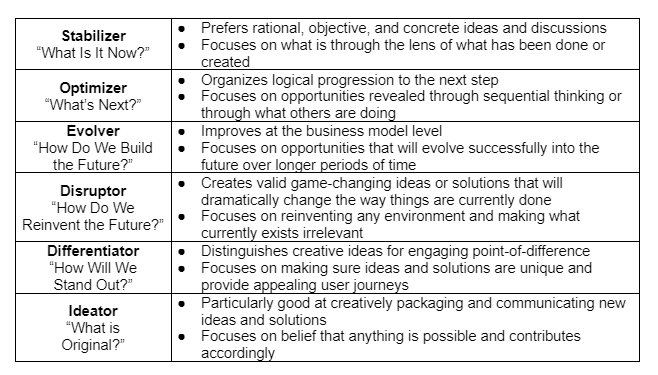
Criticals, Creatives, and Switchers
When we plot these innovation Thinking Profiles, here is how they come out:

As shown in the graphic:
- Stabilizers and Optimizers lead with critical thinking, using analytics to inform and build out their strategy.
- Differentiators and Ideators lead with creative thinking, using imagination to create and distinguish ideas.
- Evolvers and Disruptors switch back and forth, with Evolvers tending to lead with critical thinking and Disruptors leading with creative thinking to create and problem-solve ideas.
My response to both the Chief Digital Officer and the Start-Up CEO was somewhat the same:
- The team is the vehicle that creates greatness in our organizations.
- Getting the composition and chemistry right is an ongoing practice that we should be striving to improve every day.
- Although everyone uses both critical and creative thinking every day, each profile has a more dominant trait that they prefer to lead with when faced with a challenge. We must honor that to get the most out of our teams.
With the right balance of Thinking Profiles, teams can evolve over time, learning when to rely on one type of thinking or another.
Up Next in the Series
Hero Tasks. Bringing out your genius and resilience in your innovation teams.
All Call to Action
Ready to learn more about assembling effective innovation teams, Intentional Innovation®, and how Teaming Worldwide can help you solve your business’s most pressing innovation pain points? Let’s connect. Visit www.teamingworldwide.com/innovation to schedule a discovery call or email hello@teamingworldwide.com.





